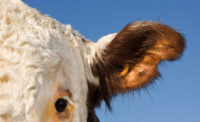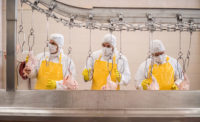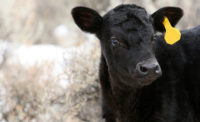Food Safety
Traceability in the meat and poultry industry
A slow race to trace: Industrywide traceability of meat and poultry has the potential to boost sales, food safety and consumer confidence, but implementation hurdles abound.






Tracing meat and poultry from farm to plate is an idea that’s time has perhaps not yet come.
While tracking can potentially help generate large increases in category revenues, shopper loyalty and product safety, such factors as cost, privacy and complexity keep many producers and processors on the sidelines.
“There is limited progress with traceability and a long way to go as an industry to embrace the idea and find a way to implement it,” says Derrell Peel, professor of agribusiness and extension livestock marketing specialist in the Department of Agricultural Economics at Oklahoma State University, in Stillwater. “But it is an increasingly important issue that is not going to go away.”
A key obstacle is a lack of understanding about the need and value of traceability, along with concerns that government agencies will use the data to monitor industry operators, Peel says.
“Implementing any traceability system requires wiping away the illusion of anonymity, and that is a big hurdle,” he says, noting regulators already can track operator activity if they so desire.
Yet, traceability is important as consumers increasingly want to know how and where a product was produced, Peel says, adding that meat and poultry sector participants are “missing out on value opportunities” by not tracking the origins of products.
Traceability, for instance, can enable downstream cattle producers to reduce expenses by not duplicating the vaccinations that were previously given to animals and also determine the most appropriate feeding regimens for specific animals based on past activity, says Brian Adam, a professor in the Department of Agricultural Economics at Oklahoma State University.
He says many processors and retailers also are willing to better compensate producers who provide data on the product attributes consumers seek, such as being all-natural, organic and raised in a sustainable environment.
“That can encourage producers to provide more animals with those characteristics,” Adam says.
Lack of traceability also prevents U.S. operators from exporting products to many international markets and from potentially identifying the source of disease outbreaks and contaminated products in the quickest manner, he says.
While there are technologies to track animals from the farm to processing plants, it is much more difficult to then monitor the hundreds of meat and poultry pieces that can come from a single carcass as well as the multiple selections in boxes that often originate from different animals, Adam says.
Adding to the challenge is the need to link myriad identification systems, starting with the plastic tags on calves that operators often replace as animals enter feedlots, along with radio frequency identification and proprietary electronic technologies, Peel says.
Tell it like it is
Overcoming such hurdles, however, can lead to large rewards, particularly because shoppers expect full transparency regarding their meats, says Jarrod Sutton, vice president of domestic marketing for the Des Moines-based National Pork Board (NPB).
“Traceability allows us to say to consumers, ‘This is where your food comes from, this is what’s in it and here’s why you can feel good about eating this and serving it to your friends and family,’” he says. “If traceability can lead to greater consumer confidence, it should also lead to increased purchasing frequency.”
The biggest obstacle in tracing pork’s origin, meanwhile, is identifying animals as they move through processing plants, says Andy Brudtkuhl, NPB director of emerging technology.
He notes the NPB is working with the North American Meat Institute (NAMI) and several packers and processors to consider ways to solve the issue, including the possible use of DNA technologies.
“More people need to understand and appreciate why this is important and how traditional traceability systems are evolving,” he says. “The second step is to join consortiums and pilot projects to test how these new networks can work.”
Sutton says, “Brands would be wise to engage thought leaders and tech companies to assist them in strategic planning.”
A laundry list of requirements
A comprehensive system, meanwhile, must be practical, cost-effective and able to accomplish the intended outcome if it is to gain widespread acceptance, says David Moss, general manager of the Calgary-based Canadian Cattlemen’s Association.
He says there is growing interest in ultra-high frequency identifiers, which enable animals “to move at the speed of commerce with minimal human intervention” during tracking.
“The biggest cattle-tracing hurdle is overcoming the extensive, versus intensive, productive system,” Moss says. “Cattle graze on open pastures for the majority of their lives and managing the movement reporting is exponentially more difficult than for other proteins that are produced in a closed, or controlled, production model.”
To help meet the challenges, Canadian beef industry members are working closely with provincial regulators and the federal government “to find a path that will be both cost- and outcome-effective,” he says.
Among the technologies that track the origins of products, radio frequency identification and ultra high frequency are proving successful in the beef sector with electronic IDs gaining overall traction, says David Gregg, consulting projects manager for World Perspectives, an Arlington, Va.-based agri-food consulting firm and developer of a feasibility study on identification and traceability covering the U.S. beef cattle industry.
“Use of electronic tracking is improving and keeping pace with general technological advances,” he says.
Gregg adds the beef industry is increasingly recognizing the need to address animal and product tracking.
“This evolution in discussion is very important, particularly because of the diversity in the sector,” he says.
Traceability is easiest to implement in industries with more tightly coordinated supply chains because there are fewer barriers to organizing information and for companies to enter into contracts to exchange data, Adam says.
He says, for instance, that the poultry sector is typically more coordinated vertically than the pork industry, which is more tightly integrated than the beef sector.
The chicken and the egg
Yet even with a growing understanding of the benefits of animal traceability, implementation is slow in part because no specific party has an incentive to lead the way, Peel says. “While there are consumers who clearly want more information about their products, there is also the question of whether the shoppers will be willing to pay more for selections that have the necessary data, and if so, how much more.”
In addition, while technologies are available to support information transfer, such as distributed ledger databases, industry players may be reluctant to leverage systems that could enable all participants in a supply chain, including competitors, to view what many operators consider to be proprietary data, Adam says.
Cattle producers also may worry that a system will more easily enable regulators to trace an animal disease or a food safety event to an individual operator, he says.
Adam says another barrier to widespread traceability is concern about system inequities. Cow and calf producers, for instance, may see themselves as paying the highest price for a system because they are at the beginning of the supply chain, while perceiving the largest processors will receive the bulk of the benefits, he says.
“Participants must be able to identify value-added opportunities despite being separated by several stages in the supply chain,” Adam says. “It seems that a trusted party, such as a coalition of producer groups and processors, may be needed to establish relationships and build trust.”
Peel says it might take a major food safety outbreak, such as foot and mouth disease, to trigger development and adoption of an industrywide traceability program.
“One system that is comprehensive and done right would benefit everyone,” he says. NP
Looking for a reprint of this article?
From high-res PDFs to custom plaques, order your copy today!













